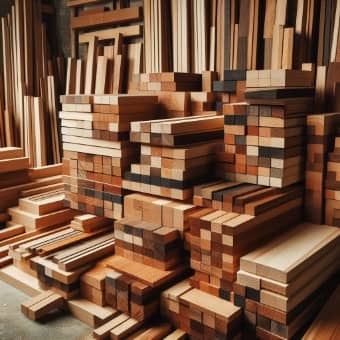Unveiling the World of Wood Types and Properties
The Carpenter’s Canvas
Every great artist needs the perfect canvas to bring their vision to life. For woodworkers, that canvas is the wood itself. Understanding the different wood types and their properties is essential for crafting beautiful and functional pieces that will stand the test of time.
In this comprehensive guide, we’ll delve into the fascinating world of wood, empowering you to confidently select the right wood for your woodworking projects.
This web page contains affiliate links. When you click on a link on this page and make a purchase, I may earn a small commission, at no additional cost to you. Thank you for your support.
Wood Classification: Understanding the Grain
There are two main classifications of wood: hardwoods and softwoods. This distinction isn’t based on hardness alone, but on the tree’s seed cone structure.

Hardwoods: These come from broadleaf trees with a closed-grain structure. This means the grain is tighter, making hardwoods denser, heavier, and more challenging to work with.
However, hardwoods offer superior strength, durability, and a beautiful finish, perfect for furniture, cabinetry, and high-end projects. Popular hardwoods include mahogany, oak, maple, cherry, and walnut.
Softwoods: Derived from cone-bearing trees, softwoods have a more open-grain structure. This makes them generally lighter, easier to work with, and often more affordable. However, softwoods may be more susceptible to dents and scratches.
They are ideal for framing, construction projects, and some furniture applications. Common softwoods include pine, spruce, fir, cedar, and redwood.
Wood Properties: Choosing the Right Wood for the Job
Beyond classification, several key properties influence your wood selection:
Hardness: As mentioned earlier, hardwoods are generally harder than softwoods. This translates to better resistance to dents and scratches, making them ideal for high-wear applications like countertops and flooring.
Grain: The grain refers to the pattern of the wood fibers. Straight grain offers predictable cutting and easier woodworking, while figured grain (wavy or curly) adds a unique aesthetic touch but can be trickier to work with.
Density: Denser woods are heavier and more durable. However, they can also be more challenging to plane, saw, and drill.
Color and Figure: Wood comes in a stunning array of natural colors, from light and pale to deep and rich. Additionally, some woods exhibit unique figuring patterns that add visual interest to finished projects.
Stability: Wood’s tendency to warp or crack with moisture changes is a critical factor. Stable woods like maple and walnut are ideal for fine furniture, while less stable woods like pine may require careful drying and construction techniques.
Empowering Woodworkers with Knowledge
Whether you’re a seasoned woodworker or just starting your journey, by understanding the nuances of wood types and properties, you’ll be well-equipped to select the perfect material for your woodworking endeavors. Happy crafting!
